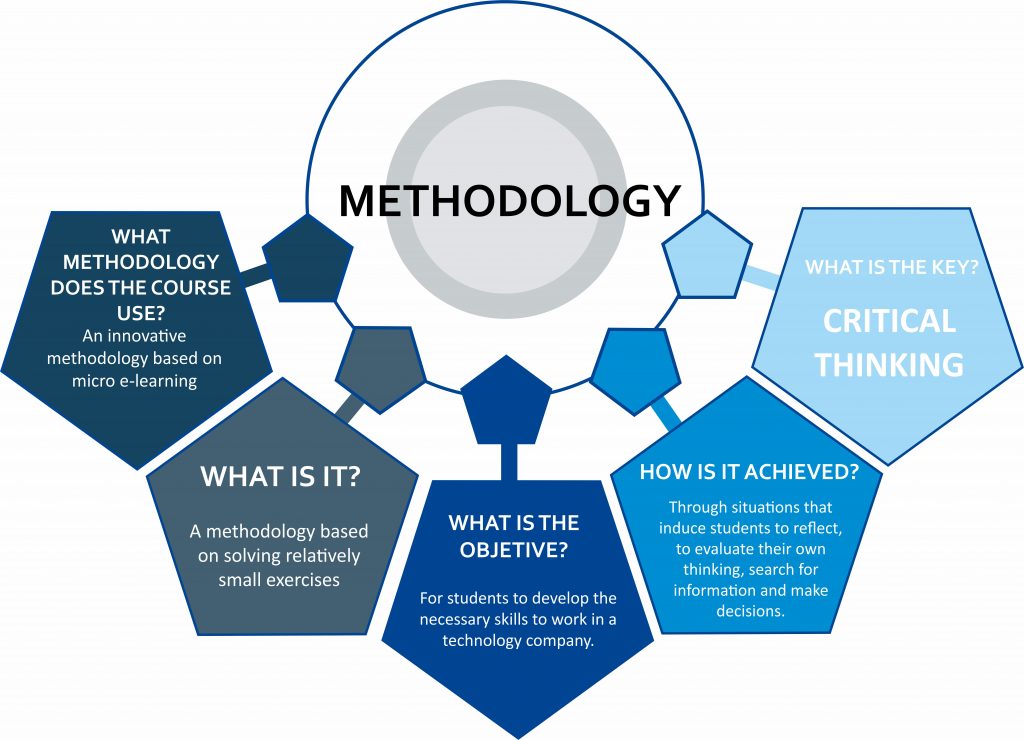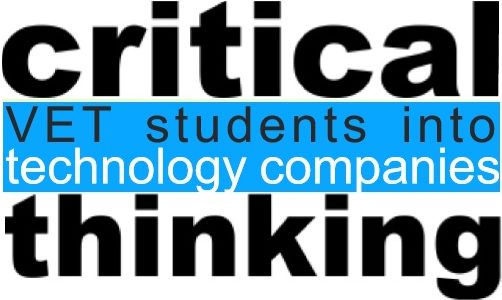.
PERSONALIZED DIGITAL COURSE FOR LABOR TRAINING IN A TECHNOLOGICAL CENTER
PRESENTATION
DESCRIPTION
The personalized digital course consist of an innovative structured virtual course specifically aimed at students developing specifically the competences of the VET training curriculum related to the digital and technological field, as well as the skills that are required in the workplace where they perform their mobility.
This course, with a personalized digital format, is aimed at VET students or graduates who are going to start their professional career in a technology company, perhaps through their curricular internships or with a first employment contract.
We intend to give another point of view on how to approach problems in the company through critical thinking, because throughout the work in technology companies, students will continually encounter new situations and problems that require a solution.
OBJECTIVES
The main objective of the course is to develop in the VET student the specific skills required by a technology company to fit into multidisciplinary teams and assume some role in cutting-edge technological innovation projects, as well as to develop critical thinking and transversal skills that guarantee their social inclusion and labor.
The objective of this course is not so much to provide new knowledge as to develop specific skills for innovative work. The course aims at allowing the students to face problems or tasks unknown to them until then. Critical thinking skills that are addressed are self-training, assess their own way of reasoning, set objectives, raise relevant questions, state hypothesis, search for information, intellectual integrity, oral and written communication, work in multidisciplinary teams.
If it is used by a VET student who does not participate in the mobility of the network, it shows training contents for employability in technological centers, compatible with the educational itinerary of Vocational Training of the partner countries, enhancing their capacity for critical thinking and the skills that are required in these companies.
If the user is going to make a mobility within the TRAINING PROGRAM IN HIGH TECHNOLOGY WORK CENTERS, then it generates an individualized training itinerary adapted to the job chosen to perform the mobility.
METHODOLOGY: THE MICROLEARNING
This course generates an innovative methodology, based on microlearning, where instead of generating theoretical contents to use, learning is based on solving small exercises through the autonomy and self-discovery of the student.
Through this method a personalized education itinerary is built based on previous knowledge of the student and the needs and work field of the technology company. Besides its contents strengthen critical thinking as an essential mechanism for work in both dynamic and technology sectors. For that purpose, the student is asked a series of questions in the form of problems that, in addition to being related to the study plans of VET studies, require for their solution the search for information, its analysis and many times the making of a decision or adopting a personal position on it.
The idea behind the methodology proposed in this course is to show situations in which the student needs to learn something independently. We try to convince them that the key ingredient to be successful in this learning process is critical thinking and that to develop it, it is necessary to acquire a series of skills and become aware of certain keys of how our mind works when we leave it on automatic pilot.

PERSONALIZATION
The course begin with an initial test that allow the tutor to customize its itinerary for each student. The selection of the course contents for each of the students are based on a self-evaluation that allow the selection of exercises related to the second block of content, since the exercises of the first block of content are common to all students, while those in the third block depend on the technology company in which they will carry out the internship.
Throughout this short initial test, students may come across questions such as:
If a plastic is rigid at room temperature…
a) … it is certain that it is crystalline.
b) … it has a glass transition temperature higher than room temperature.
c) … it can be deformed more than 1%.
d) … it is sure to be semi-crystalline.
When must a differential relay trigger and ensure the opening of the circuit?
a) When a short circuit of intensity higher than that allowed by the relay occurs.
b) When a moderate overcurrent occurs.
c) When the current derived to earth reaches a value greater than the sensitivity of the relay.
d) When the fault current is less than half the sensitivity of the relay.
One of the following 4 characteristics is applicable to the function f(x) = log (x + 2) ?
a) It is a straight line.
b) It doesn’t reach a value higher than 2 until x > 1000.
c) The function decreases the more x increases.
d) It never has the value f(x) = 0.
CONTENT

This result raises an adapted learning, which builds the contents according to the specific needs of the user, but above all adapting them to the needs of the workplace where they will carry out their long-term mobility. This training course have been structured around a DIDACTIC PROGRAMMING with the following sections:
1. INTRODUCTION
2. MOTIVATION. GOALS. CONTENTS
3. METHODOLOGY: MICROLEARNING
4. COMPETENCES
4.1. BASIC SKILLS OF CRITICAL THINKING
4.2. SCIENTIFIC AND TECHNICAL SKILLS
5. CONTENTS AND MICRO-PILLS
5.1. CONTENTS FOR THE DEVELOPMENT OF CRITICAL THINKING
We intend to give another point of view on how to approach problems in the company through critical thinking, because throughout the work in technology companies, students will continually encounter new situations and problems that require a solution.
For each unit, the competences that the student must have in order to access the technology sector have been specified, building a number of fundamental transversal competences to motivate, develop self-confidence and the inclusion of users, as well as foster critical critical thinking to work in the scientific field.
5.2 SCIENTIFIC AND TECHNICAL CONTENTS
The contents of this didactic program have been created through the compilation of materials generated by the participating teachers and experts or collaborators that promote the development of certain skills in VET students. It will group a broad spectrum of knowledge that allow, based on their initial knowledge, their needs and objectives, to achieve the selection of the most appropriate Teaching Units shaping a specific itinerary.
We intend for students to exercise how to address technical problems that may arise at work in a technology company. We seek to be able to grow professionally and increase our knowledge and capabilities throughout life.
5.3. SPECIFIC CONTENTS. PROPOSALS OF THE CENTERS THAT WILL RECEIVE VET STUDENTS
If the student is going to participate in a long-term mobility in a technological center of the network, the course will be extended with a specific Didactic Unit for the training of the student for the job and the company where the mobility will be carried out.
It consist of exercises proposed directly by the companies in which the students are going to carry out the internships. It is intended to facilitate, to a certain extent, the student’s first contact with the company.
DO YOU WANT TO ACCESS THE COURSE?
DO YOU WANT TO DOWNLOAD THE COURSE?
IF YOU WANT TO BE A TESTER…
You can download the contents of the course from this web. But if you want to try any of the pills….
ACCESS TO THE LINK BELLOW
You have to press the next button, you will find some pills (short excercices) that you must complete in 15 min… no more than 20 minutes. You will find also three helps to make it easier, but you are the main character and you have to find the solution using internet, your own Vet materiales…
YOUR OPINION IS IMPORTANT FOR US


